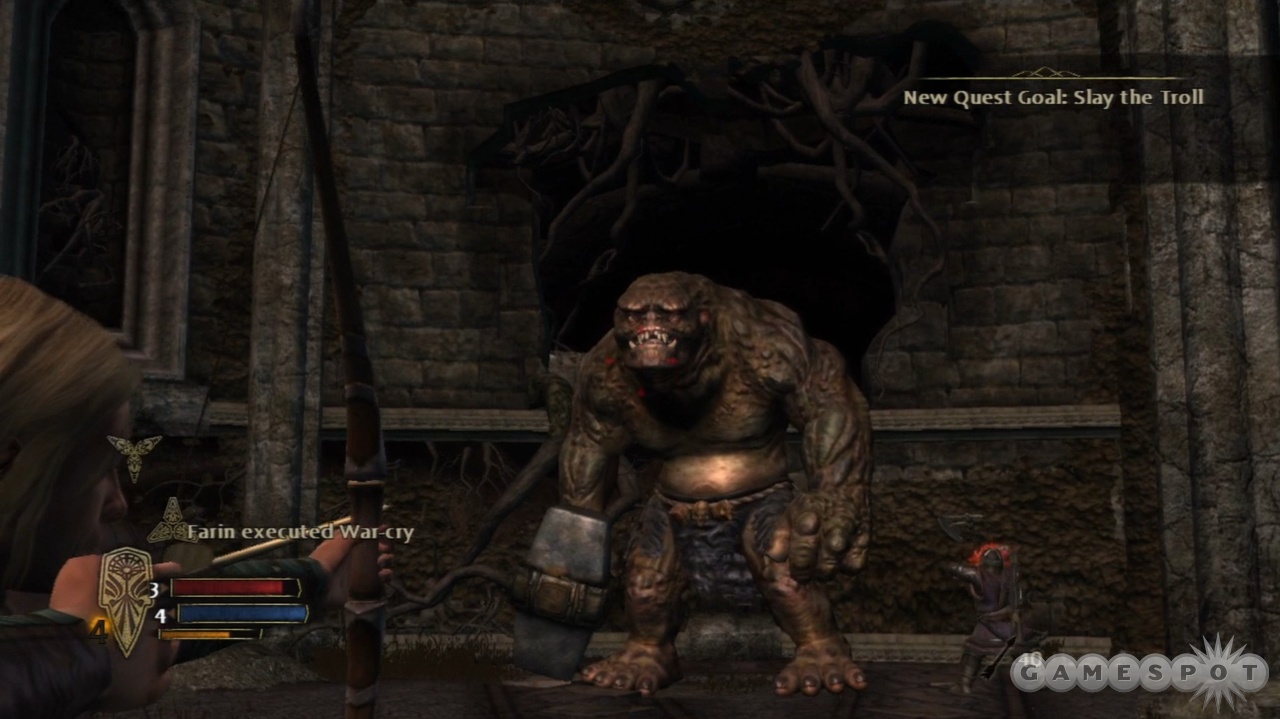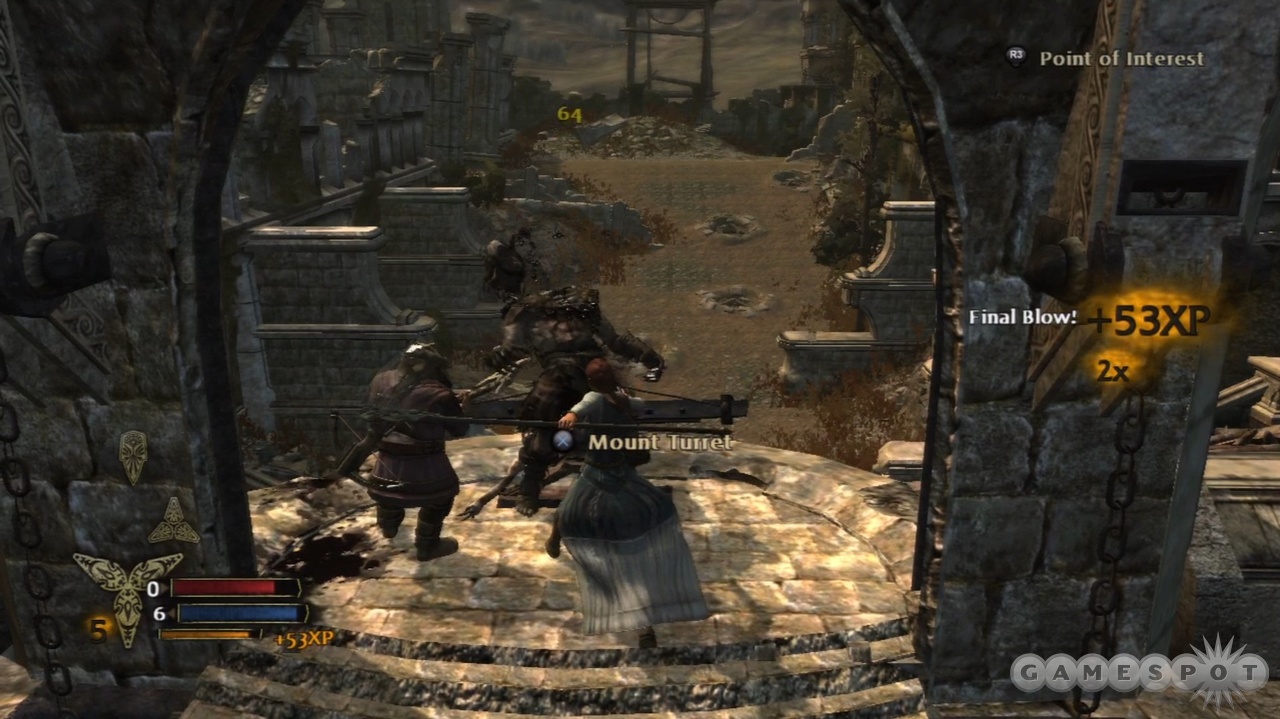It's not fair. Frodo, Gandalf, Aragorn, and the rest of the fellowship get all the glory, but without the brave struggles of so many others, they never could have succeeded on their vital errand. The Lord of the Rings: War in the North tells the tale of three new heroes who helped make the fellowship's success possible, and it gives you much of what you'd want from a hack-and-slash role-playing game set in Middle-earth. There's plenty of great loot to collect, a number of powerful abilities to acquire, and tons of orcs and cave trolls to slay. Unfortunately, these bright spots only make it that much more disappointing when frustrations arise and overshadow this heroic adventure, as they so often do.
Andriel of Rivendell; Eradan of the Dunedain rangers; and Farin, champion of Erebor, are thrown together by war and join forces. This union of elves, dwarves, and men sets out to foil the evil forces of Agandaur, a servant of the dark lord Sauron whose schemes threaten free peoples residing far from the conflicts in Rohan and Gondor. The story is typical, but it provides an excuse to send you to creepy barrows, snowy mountains, dwarven mines, and other places that evoke the atmosphere of the Lord of the Rings films. And fans of J.R.R. Tolkien's books will appreciate appearances by characters from the novels that were left out of the movies.
Regardless of which hero you select, your basic abilities in battle are the same. You have light and heavy melee attacks and a ranged attack. After enemies suffer some damage, a symbol indicates that they're vulnerable to a critical strike, and performing a heavy attack at this moment does extra damage and may sever some limbs, even if you're wielding a dull staff. The sight of limbs flying and black blood spilling brings some grim satisfaction to the combat, but that satisfaction is too often lost in frustration. In the early hours, you don't have enough abilities for combat to stay interesting for long, but you still have to fight wave after wave of similar enemies. Flawed collision detection results in some attacks that appear to hit without causing damage, as well as some attacks that don't appear to hit yet knock off a chunk of your life. And certain early enemies, like the self-destructive goblin sappers, do so much damage that you might spend way too much time crawling around on the ground, waiting to be revived by one of your fellow party members.
War in the North utilizes a revival system similar to that seen in Gears of War and numerous other games; when your health is depleted, one of your companions needs to get near you and hold down a button for a few seconds. Then you hop back on your feet, good as new. Enemies awkwardly stop attacking you and just stand around once you go down on your knees, though they mercilessly attack those who come close in an attempt to rescue you. When you're trying to revive a downed companion, you may find him or her surrounded by enemies whose attacks knock you to the ground for a few seconds. This isn't an enjoyable challenge to overcome, and it can make reviving your companion before he or she dies all but impossible. When you fail and are forced to restart, you often find that you've been set back considerably and need to replay surprisingly lengthy and difficult sections. There's no option to save manually, so you're at the mercy of the game's infrequent autosaves.

As you level up, you put points into skill trees and acquire useful new techniques, which makes combat more fun. Andriel can cast a shielding dome that heals party members, for instance, while Eradan can unlock dual-wielding and become a much more effective damage dealer. You also periodically get your hands on exciting loot, and it feels good to mow down hordes of enemies with your new flaming sword or to slot a gem into your hammer that makes it deal shock damage. Though these elements make your progress more rewarding, they can't dispel the demons that plague your journey. For instance, during one battle in which you must prevent Agandaur's forces from shattering a door, you may find your attempts to fend off two trolls seemingly hopeless because they can destroy the door with a few quick blows. But if you simply stay away from the door and pick at the trolls with ranged attacks, they might just stand by the door harmlessly, as if they have forgotten their mission.
If you tackle this adventure alone, your AI companions do a decent job of assisting you. Although they let you do most of the slaughtering, they at least make a convincing show of fighting off the orc hordes, and Andriel regularly conjures her healing sanctuary when you are in need. But War in the North is a game about fellowship, and it's more fun to face its joys and frustrations with friends. Unfortunately, the online multiplayer has its own problems. If you invite a friend to join you who hasn't played through as much of the game as you, the disparity in character levels can make it difficult to progress together. Technical issues also interfere with your cooperative quest. Enemies might appear to be dead to one player but alive to another, or you might see prompts informing you that your friend is dying and needs your aid when he or she is perfectly fine.

War in the North's visuals make good use of atmospheric details; the falling leaves in Rivendell create a feeling of autumnal melancholy, and the swirling snow on a frigid mountain might send shivers down your spine. But the environments, and the ways you interact with them, aren't always believable. You might see a treasure chest just a short distance up a river, for instance, but because your character can't climb or leap up the three-foot slope in the riverbed, you must find a different path to reach it. Battle animations similarly take you out of the moment at times. In addition to severing limbs with staffs, you might impale orcs with dull, hefty hammers or do other things that don't make sense, even in this fantasy world.
There are times when War in the North shows you the game it could have been--when the exhilaration of mowing down fearsome foes or the satisfaction of seeing your character become more powerful makes you want to press forward. But each time the game starts to hit its stride, it soon stumbles and falls on its face. For a trio of heroes whose destiny is to save the northern regions of Middle-earth, this fellowship spends too little time earning glory and too much time crawling around in the mud.